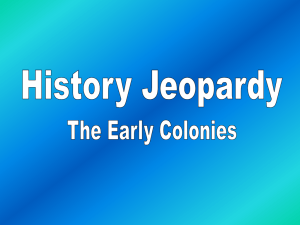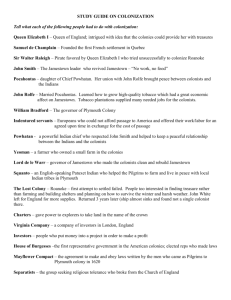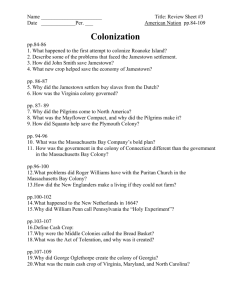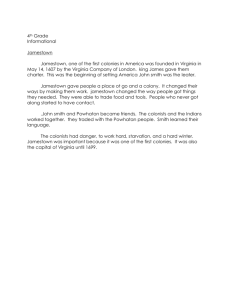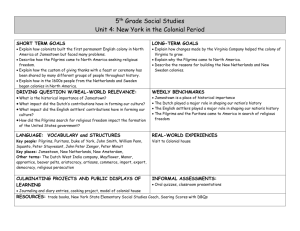Tensions on the Rise
advertisement
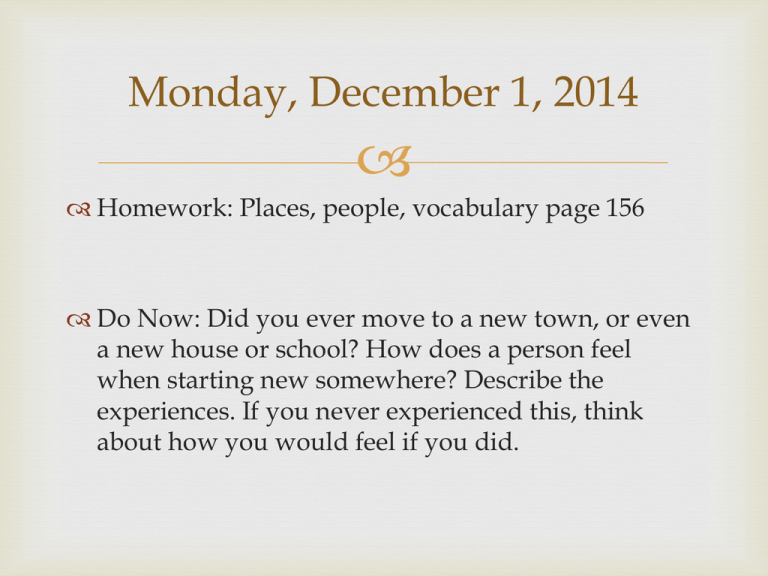
Monday, December 1, 2014 Homework: Places, people, vocabulary page 156 Do Now: Did you ever move to a new town, or even a new house or school? How does a person feel when starting new somewhere? Describe the experiences. If you never experienced this, think about how you would feel if you did. Tensions on the Rise Tensions were growing between England and Spain, especially when it came to colonization of the New World England’s attempt to colonize North America and the English sea captains raiding Spanish ships for gold and silver angered the Spanish king greatly The Last Straw Francis Drake was one of the noteworthy captains in England. He had raided a Spanish ship on a trip around the world and brought back gold and silver This made him a hero in England, but Spain needed retaliation In 1588, King Phillip decided to attack England by assembling the Spanish Armada Spanish Armada A huge fleet of war ships (Armada is the Spanish word for fleet) With 130 ships carrying 30,000 soldiers and sailors, the Spanish were confident of a victory English navy gets victory The English navy had some important advantages The ships were smaller and moved faster with more powerful guns Of the Spanish Armada’s 130 ships, only about 60 made it safely back to Spain Now, England could turn their attention back to colonies in North America The Virginia Company In 1606, a group of merchants formed the Virginia Company of London They asked King James I for a charter to set up a colony in Virginia The owners raised money by selling stock where each person would earn a profit if the colony was successful The Jamestown Colony In 1607, 3 English ships carrying about 120 colonists reached the eastern coast of Virginia They traveled along a river which they named James River to honor the King When they picked a spot to set up their colony, they called it Jamestown What they thought would be a great land turned out to fail Jamestown, not so great Land was low and swampy Air was full of disease-carrying mosquitos River water was not healthy to drink Almost as soon as they had arrived at Jamestown, many settlers began to die Wednesday, December 3, 2014 No Homework Do Now: Read pages 160-162) Gold in Virginia? Some Jamestown colonists were so focused on finding gold that they neglected building shelter or planting food By the end of their first year, only 38 of the first settlers were alive John Smith was elected leader and made some changes Under Smith’s leadership The colonists built houses and dug wells for fresh water Smith began trading with Chief Powhatan (the corn from the Powhatans helped keep colonists alive) Things were peaceful between the colonists and the Powhatan people Pocahontas She was the young daughter of Chief Powhatan who often visited Jamestown John Smith later wrote that when he first met the chief, Smith was taken prisoner and 12 year old Pocahontas convinced her father not to kill him Without John Smith Smith returned to England in 1609 Without his leadership, the colony suffered People died of hunger so often that this time became known as the “starving period” The colony dwindled until England sent over new colonists with a new leader, Lord De La Warre Tobacco helps Jamestown Tobacco was native to the Americas and the native people had shown early settlers how to plant and grow it Tobacco became popular in Europe which helped make it Virginia’s first cash crop Although the king did not approve, tobacco was rapidly being shipped to England Farmers needed help Because tobacco popularity was growing so quickly, farmers needed help Thousands of English indentured servants began arriving in Jamestown Between 1619 and 1622, many of the newly arrived indentured servants died of disease or overwork and mistreatment of their masters Colony of Jamestown continues to grow Later, Africans were brought over and sold to help the work effort The marriage of John Rolfe and Pocahontas in 1614 helped maintain peace between the English settlers and the Powhatan people Wednesday, December 10, 2014 Homework: page 43 workbook Do Now: Hand in Pocahontas paragraphs Read “You Are There” on page 164. Why is Samual de Champlain looking for a specific river? What is he hoping to discover? Samuel de Champlain A French explorer who was part of an expedition exploring the St. Lawrence River (present-day Canada) The expedition was a search for the Northwest Passage (waterway connecting the Atlantic and Pacific Oceans making it easier to sail between Europe and Asia) Quebec and Montreal Champlain founded the French colony of Quebec on the St. Lawrence River Quebec was near forests full of beavers and beaver fur was very profitable Quebec thrived and became a trading center The French also founded Montreal, together this region became known as New France Dutch settlements 1609, Dutch leaders sent English sea captain Henry Hudson to search for a new water route to Asia Hudson sailed up a river hoping it was the Northwest Passage, but when it proved to be too shallow for the boat to sail through, he claimed the land for the Dutch (known as New Netherland) New Amsterdam 1624 – Dutch settlers began building the town on Manhattan island Here, the Dutch could control trade on the Hudson River, later making New Amsterdam the biggest most important Dutch settlement in North America Friday, December 12, 2014 Chapter 5 test next Friday! If you will be away, you must take it early! Do Now: take out last night’s homework (page 167 – letter to ruler) Reasons to come to North America Gain wealth Spread their religion Live on land of their own Some came for religious freedom Seeking religious freedom England at this time had separated from the Roman Catholic Church They had their own church formed by King Henry VIII, but many felt it was too much like the Roman Catholic Church Separatists A group became known as Separatists because they wanted to separate from the Church of England They often faced persecution William Bradford was a leader of the group and decided to leave England to start a settlement of their own Pilgrims These colonists coming over to worship freely became known as the Pilgrims A person who journeys for religious reasons Bradford went to the Virginia Company and asked permission to live on the land of Virginia He knew troubling times were up ahead The Mayflower September 1620 – about 100 Pilgrims crowded a small ship called the Mayflower This ship was pushed off course and landed in Cape Cod John Smith had named this region New England Once the Pilgrims arrived they chose a rocky harbor which they called Plymouth Planning Ahead Before even landing the ship, the Pilgrims decided to write a plan of government for their colony Mayflower Compact This said “just and equal laws…for the general good of the colony” Wednesday, November 27, 2013 HAPPY THANKSGIVING! Do Now: What led to the pilgrims leaving England? A warm welcome In early spring, while the Pilgrims were at work planting seeds, a Native American named Samoset walked onto their settlement and said “Welcome Englishmen!” This meeting began a period of friendly relations between the Pilgrims and the Wampanoag Keeping Peace Samoset explained about another Native American named Squanto He had been captured and sold into slavery in Spain. When escaped he had gone to England and learned English Later, Squanto came back to live with the Wampanoag. He acted as a translator when forming a peace treaty between the Pilgrims and Massasoit (Wampanoag leader) The First Thanksgiving Squanto and the Wampanoag continued to help by showing how and where to hunt and grow corn The Pilgrims decided to hold a celebration of thanksgiving. Together, they feasted on deer, wild duck, lobster, fish, cornbread, pumpkin, squash, berries and wild plums. The 3 day celebration included games and races
